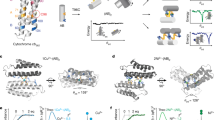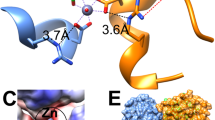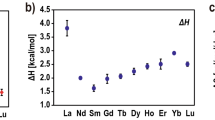Abstract
We describe the successful design of a tetrahedral His3Cys Zn(II)-binding site in a small protein of known structure: the B1 domain of Streptococcal protein G. The B1 variants containing the novel metal-binding site were characterized using a combination of optical absorption, circular dichroism and NMR spectroscopies. The results indicate that the designed proteins bind Zn(II) with high affinity and tetrahedral coordination geometry, and that the overall secondary and tertiary structure of the B1 domain is maintained.
This is a preview of subscription content, access via your institution
Access options
Subscribe to this journal
Receive 12 print issues and online access
$189.00 per year
only $15.75 per issue
Buy this article
- Purchase on Springer Link
- Instant access to full article PDF
Prices may be subject to local taxes which are calculated during checkout
Similar content being viewed by others
References
Regan, L. The design of metal-binding sites in proteins. A. Rev. Biophys. biomol. Struct. 22, 257–281 (1993).
Corey, D.R. & Schultz, P.G. Introduction of a metal-dependent regulatory switch into an enzyme. J. biol. Chem. 264, 3666–3669 (1989).
Higaki, J.N., Haymore, B.L., Chen, S., Fletterick, R.J. & Craik, C.S. Regulation of serine protease activity by an engineered metal switch. Biochemistry 29, 8582–8586 (1990).
Kellis, J.T., Jr, Todd, R. J. & Arnold, F.H. Protein stabilization by engineered metal chelation. BioTechnology 9, 994–995 (1991).
Ghadiri, M.R., Soares, C. & Choi, C. Design of an artificial four-helix bundle metalloprotein via a novel ruthenium(II)-assisted self-assembly process. J. Am. chem. Soc. 114, 4000–1002 (1992).
Iverson, B.L. et al. Metalloantibodies. Science 249, 659–662 (1990).
Handel, T. & DeGrado, W.F. De novo design of a Zn2+-binding protein. J. Am. chem. Soc. 112, 6710–6711 (1990).
Pessi, A. et al. A designed metal-binding protein with a novel fold. Nature 362, 367–369 (1993).
Regan, L. & Clarke, N.D. Atetrahedral zinc(II)-binding site introduced into a designed protein. Biochemistry 29, 10878–10883 (1990).
Gronenborn, A.M. et al. The immunoglobin binding domain of Streptococcal Protein G has a novel and highly stable polypeptide fold. Science 253, 657–661 (1991).
Brünger, A.T. X-PLOR Version 3.1: A system for X-ray crystallography and NMR (Yale University Press, New Haven, 1992).
Smith, C.K., Withka, J.M. & Regan, L. A thermodynamic scale for the β-sheet forming tendencies of the amino acids. Biochemistry 33, 5510–5517 (1994).
Bertini, I. & Luchinat, C. High spin cobalt(II) as a probe for the investigation of metalloproteins. Adv. inorg. Chem. 6, 71–111 (1984).
Krizek, B.A., Merkle, D.L. & Berg, J.M. Ligand variation and metal ion binding specificity in zinc finger proteins. Inorg. Chem. 32, 937–940 (1993).
Lippard, S.J. & Berg, J.M. Principles of Bioinorganic Chemistry 214–215 (University Science Books, Mill Valley, CA, 1994).
Berg, J.M. & Merkle, D.L. On the metal ion specificity of “zinc finger” proteins. J Am. chem. Soc. 111, 3759–3761 (1989).
Alexander, P., Orban, J. & Bryan, P. Kinetic analysis of folding and unfolding the 56 amino acid IgG-binding domain of Streptococcal Protein G. Biochemistry 31, 7243–7248 (1992).
Brahms, S. & Brahms, J. Determination of protein secondary structure in solution by vacuum ultraviolet circular dichroism. J. molec. Biol. 138, 149–178 (1980).
Frankel, A.D., Berg, J.M. & Pabo, C.O. Metal-dependent folding of a single zinc finger from transcription factor IIIA. Proc. natn. Acad. Sci. U.S.A. 84, 4841–4845 (1987).
Párraga, G. et al, Zinc-dependent structure of a single-finger domain of yeast ADR1. Science 241, 1489–1492 (1988).
Coleman, J.E. Cadmium-113 nuclear magnetic resonance applied to metalloproteins. Meth. Enzymol. 227, 16–43 (1993).
Kim, C.A. & Berg, J.M. Thermodynamic β-sheet propensities measured using a zinc-finger host peptide. Nature 362, 267–270 (1993).
Minor, D.L. Jr & Kim, P.S. Measurement of the β-sheet-forming propensities of the amino acids. Nature 367, 660–663 (1994).
Vallee, B.L. & Auld, D.S. Zinc coordination, function, and structure of zinc enzymes and other proteins. Biochemistry 29, 5647–5659 (1990).
Lee, B.-K. & Richards, F.M. The interpretation of protein structures: estimation of static accessibility. J. molec. Biol. 55, 397–400 (1971).
Maniatis, T., Fritsch, E.F. & Sambrook, J. Molecular Cloning: A Laboratory Manual (Cold Spring Harbor Laboratory, Cold Spring Harbor, 1982).
Riddles, P.W., Blakeley, R.L. & Zerner, B. Reassessment of Ellman's reagent. Meth. Enzymol. 91, 49–60 (1983).
Wüthrich, K. NMR of Proteins and Nucleic Acids (John Wiley, New York, 1986).
Carson, M. Ribbons 2.2 Manual, (University of Alabama at Birmingham, Birmingham, 1993).
Kraulis, P. MOLSCRIPT: a program to produce both detailed and schematic plots of protein structures. J. appl. Crystallogr. 24, 946–950 (1991).
Bagshaw, C.R. & Harris, D.A. in Spectrophotometry and Spectrofluorimetry: A Practical Approach (eds Bashford, C. L. & Harris, D. A.) 91–113 (IRL Press, Washington, 1987).
Author information
Authors and Affiliations
Rights and permissions
About this article
Cite this article
Klemba, M., Gardner, K., Marino, S. et al. Novel metal-binding proteins by design. Nat Struct Mol Biol 2, 368–373 (1995). https://doi.org/10.1038/nsb0595-368
Received:
Accepted:
Issue Date:
DOI: https://doi.org/10.1038/nsb0595-368
This article is cited by
-
MC1R and melanin-based molecular probes for theranostic of melanoma and beyond
Acta Pharmacologica Sinica (2022)
-
Designing artificial enzymes by intuition and computation
Nature Chemistry (2010)
-
Computational protein engineering
Nature Structural Biology (1998)



